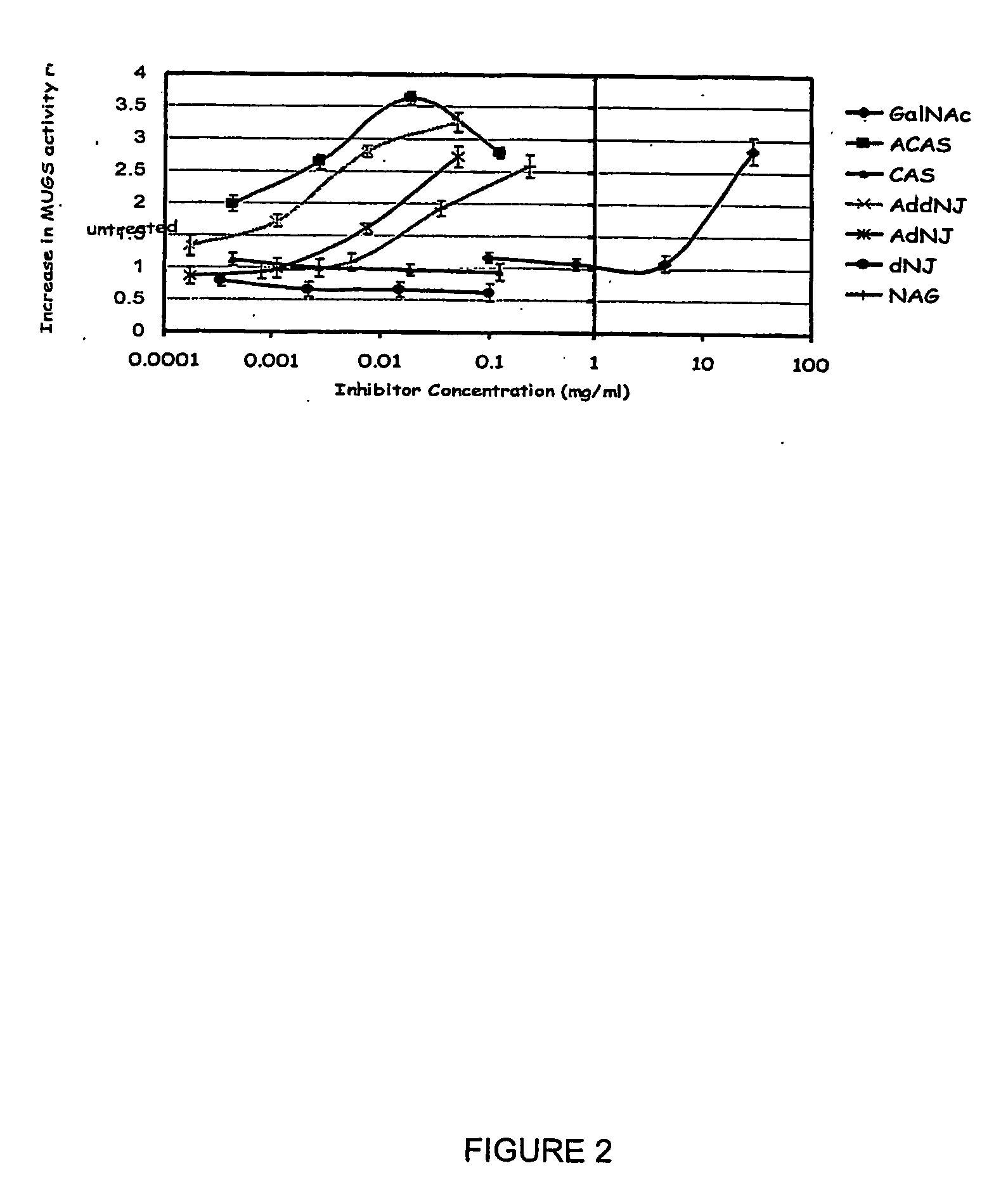Treatment of tay sachs or sandhoff diseases by enhancing hexosaminidase activity
- Summary
- Abstract
- Description
- Claims
- Application Information
AI Technical Summary
Benefits of technology
Problems solved by technology
Method used
Image
Examples
example 1
[0088] 17662 cells and wild type fibroblasts were cultured as described above in the presence of 10-100 μg / ml of one of the following:
[0089] (i) N-acetyl-β-D-galactosamine (GalNAc);
[0090] (ii) 6-acetamido-6-deoxy-castanospermine (ACAS);
[0091] (iii) N-acetylglucosamine-thiazoline (NAG-thiazoline or NGT);
[0092] (iv) 2-acetamido-1,2-dideoxynojirimycin (AddNJ);
[0093] (v) 2-acetamido-2 deoxynojirimycin (AdNJ);
[0094] (vi) deoxynojirimycin (DNJ); or (vii) castanospermine (CAS).
[0095] The structures of these compounds are shown in FIG. 1. With the exception of (vi) and (vii), all contain an acetamido group which acts as a non-enzymic nucleophile in the hydrolysis of the substrate. NAG-thiazoline is a stable thiazolium which mimics the internal oxazolium ring normally formed as the reaction intermediate. Compounds (i) to (v) are hexosaminidase inhibitors. DNJ and CAS, which are inhibitors of α-glucosidase I and II which produce the glycan substrates recognised by-the ER resident chape...
example 2
[0097] Hexosaminidase A was partially purified by DEAE ion exchange chromatography from a hypotonic lysate of 17662 or Wild Type fibroblasts cells. Heat inactivation kinetics of mutant and WT enzyme were performed (O'Brien et al., (1970), N. Eng. J. Med., v. 283, p. 15) using eluate containing hexosaminidase A activity (MUG / MUGS ratio 5:1) which was diluted with 0.1M citrate buffer pH 4.5 and incubated at 0° C. at 42° C. for 15, 30 or 45 minutes, with subsequent return to 0° C. Remaining hexosaminidase A activity was monitored using MUGS. The results are shown in FIG. 3A.
[0098] Whereas >90% wild type enzyme activity remained after 45 min. at 42° C., <50% of mutant hexosaminidase A activity remained after 30 min, i.e. its half life was reduced to about 30 min, in contrast to the wild type half life of 300 min.
[0099] For inhibitor experiments, inhibitors were diluted to a concentration which reduced enzyme activity by 50%. Inhibitors were then added to the mutant hexosaminidase A el...
example 3
[0100] 17662 cells were grown in 6 well tissue culture dishes in medium with or without inhibitor for 6 days. Subsequently, medium was removed, cells were washed twice with PBS, scraped off into 1 ml PBS, centrifuged, and pellet was resuspended in 10 mM potassium phosphate buffer pH 6.1, 1% Triton X100. Half of the aliquot was used in a western blotting experiment and the other half was used to determine the MUGS activity of the sample. For western blotting, following PAGE, transfer to nitrocellulose and blocking in non-fat dry milk, the blot was incubated sequentially with polyclonal anti-rabbit hexosaminidase A antibody and goat anti-rabbit IgG peroxidase-conjugated secondary antibody (Amersham Biosciences). Antibody binding was visualized by ECL according to the manufacturer's instructions for Amersham ECL.
[0101] The results are shown in FIG. 4. The increase in hexosaminidase activity with inhibitor treatment was accompanied by an increase in a subunit protein in the cells (FIG....
PUM
| Property | Measurement | Unit |
|---|---|---|
| Stability | aaaaa | aaaaa |
Abstract
Description
Claims
Application Information
 Login to View More
Login to View More - R&D
- Intellectual Property
- Life Sciences
- Materials
- Tech Scout
- Unparalleled Data Quality
- Higher Quality Content
- 60% Fewer Hallucinations
Browse by: Latest US Patents, China's latest patents, Technical Efficacy Thesaurus, Application Domain, Technology Topic, Popular Technical Reports.
© 2025 PatSnap. All rights reserved.Legal|Privacy policy|Modern Slavery Act Transparency Statement|Sitemap|About US| Contact US: help@patsnap.com



